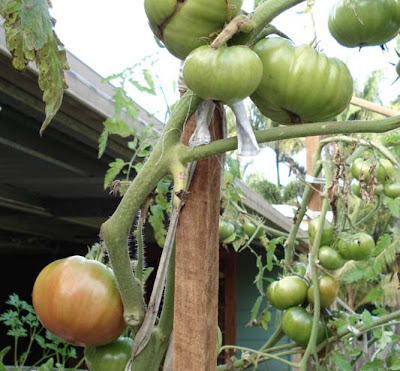I thought I'd give those interested in our aquaponics system a bit more info. Aquaponics is an intergrated system of growing fish and organic plants, our plants are vegetables. Our system is situated on the back verandah and is connected to the electrical plugs in a little brick shed closeby.
We have a 3000 litre fish tank (see above) that contains a submersible pump. Water is pumped up to the two grow beds above that are filled with gravel and vegetables. The water contains all the fish waste (ammonia, nitrates etc) and when it is pumped to the grow beds, it fertilises the plants organically. The water then falls back into the fish tank as clean water.
This is from:
How Does it Work?
In aquaponics, the nutrient-rich waste-water from recirculating aquaculture provides a food source for the growing plants and the plants provide a natural filter for the water the fish live in. This creates an ecosystem where both plants and fish can thrive. Aquaponics is the ideal answer to a fish farmer’s problem of disposing of nutrient rich water and a hydroponic grower's need for nutrient rich water.
The key to a successful aquaponic system is a healthy colony of beneficial bacteria. These bacteria convert fish waste into nitrate and other elements which are used by plants as they grow. Without the bacteria, ammonia and nitrite levels, which are toxic to fish and plants, would quickly rise.
Aquaponics can be used to produce large quantities of food in very small spaces in an environmentally friendly way.
In aquaponics, the nutrient-rich waste-water from recirculating aquaculture provides a food source for the growing plants and the plants provide a natural filter for the water the fish live in. This creates an ecosystem where both plants and fish can thrive. Aquaponics is the ideal answer to a fish farmer’s problem of disposing of nutrient rich water and a hydroponic grower's need for nutrient rich water.
The key to a successful aquaponic system is a healthy colony of beneficial bacteria. These bacteria convert fish waste into nitrate and other elements which are used by plants as they grow. Without the bacteria, ammonia and nitrite levels, which are toxic to fish and plants, would quickly rise.
Aquaponics can be used to produce large quantities of food in very small spaces in an environmentally friendly way.
This is our fish tank after it had been running for about a month.
We have enough room to humanely farm about 100 silver perch, a fish that is native to Australia's Murray-Darling river system. We chose silver perch as they're a good beginner fish, they taste good and can tolerate a wide variation in temperature.
You can see the baby perch peeking out of the plumber's pipe
These are the heirloom Brandywine tomatoes riping in the winter sun. They were planted in late March. The photo was taken this morning.


This is a marketmore cucumber, another heirloom vegetable.
It's using the celery as a growing support.
Aquaponics is a brilliant way to grow edible fish and organic vegetables and fruit in the same small area. Once your system is set up and has matured, you'll be getting organic produce simply by feeding the fish. Imagine that, no fertilising, no watering, no weeding. As a lifelong vegetable gardener, I think that's a pretty good way of growing food.
BTW, for those of you who are worried about excess water use, our system is set up entirely on rainwater we harvested from our roof. You do need to top up a little water when it evaporates off and if you have problems with water quality you might have to change some of the water, but when the system is running well, you use very little water, much less than in a conventional soil garden.
If you're thinking of setting up a system, you'll get all the help you need here:
http://www.backyardaquaponics.com/




